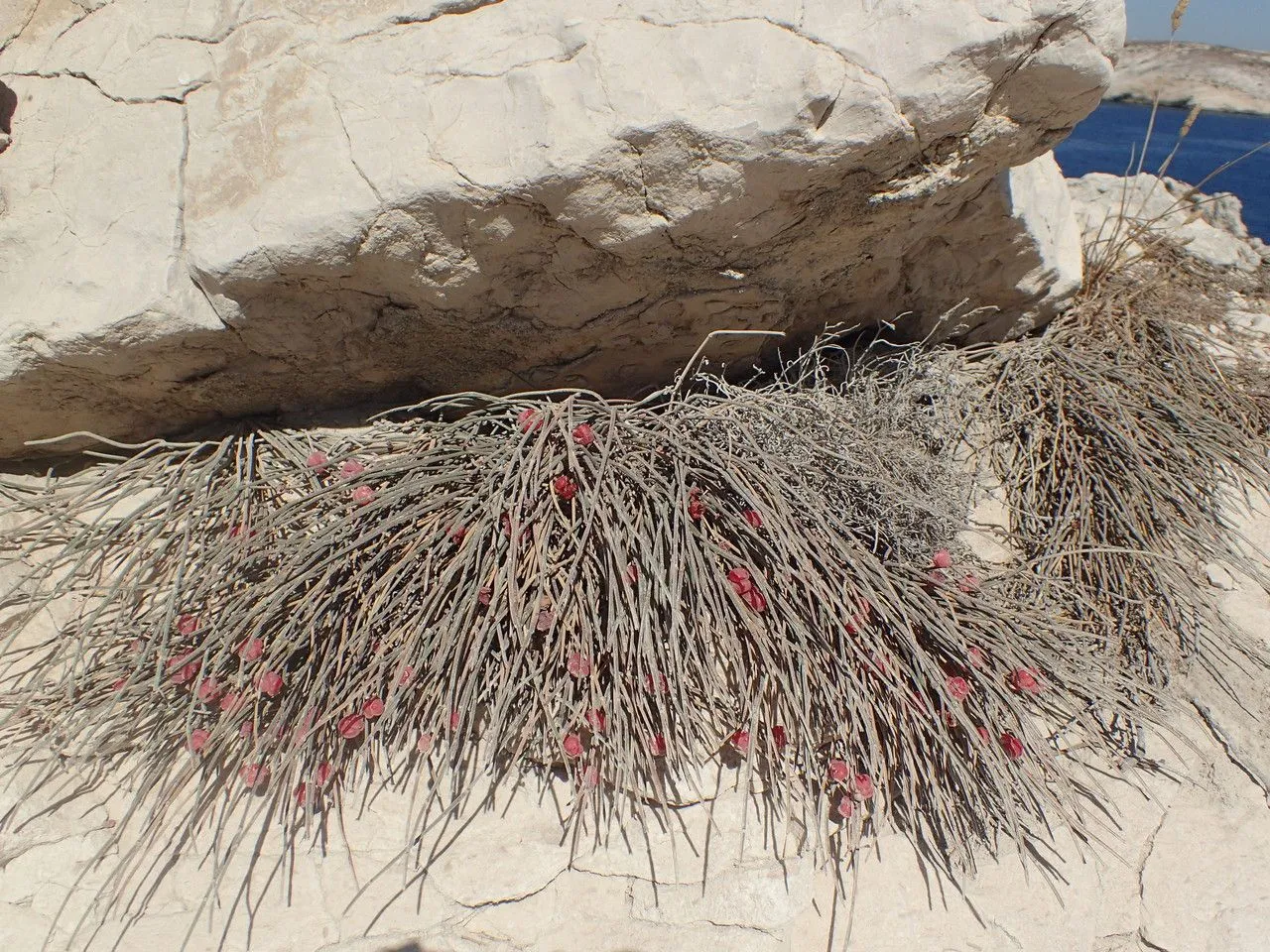
Author: L.
Bibliography: Sp. Pl.: 1040 (1753)
Year: 1753
Status: accepted
Rank: species
Genus: Ephedra
Vegetable: False
Observations: Europe to N. China and Caucasus, S. Russian Far East
The plant commonly known as Sea-grape is scientifically identified as Ephedra distachya. This resilient species thrives across a broad geographic range, extending from various parts of Europe to Northern China, and also encompassing the Caucasus region as well as the southern areas of the Russian Far East. Sea-grape belongs to the family Ephedraceae, which is known for its hardy and often shrubby members that are well-suited to surviving in challenging environments.
Ephedra distachya is recognized for its distinct and adaptable botanical characteristics which enable it to prosper in diverse climates and soils. Historically, this plant was first formally documented in the mid-18th century in Linnaeus’s seminal work “Species Plantarum” dating to 1753, underscoring its longstanding recognition and scientific significance.
The plant is notable for its clustered, grape-like fruits which perhaps contribute to its common name. These fruits are not only visually striking but also play a role in the plant’s reproductive cycle by attracting various fauna that aid in seed dispersal.
The genus Ephedra to which Sea-grape belongs, has been of interest to both botanists and historians due to its use in traditional medicine and its unique alkaloid content, particularly ephedrine. This bioactive compound has been historically utilized for its stimulant and decongestant properties, although modern use is more regulated due to potential health risks.
In summary, the Sea-grape (Ephedra distachya) is a remarkable example of botanical adaptability and historical significance. Its expansive distribution from Europe to Asia underscores its ecological versatility, and its role within the Ephedraceae family highlights its importance in both natural and cultural contexts.
Eng: jointfir, sea-grape, sea grape
Swe: russinefedra
Fra: éphédra
Zho: shuang sui ma huang
En: Sea-grape, Jointfir, Sea Grape, Join
Hy: Էֆեդրա սովորական
Az: İkisünbül acılıqotu
Ba: Таутамыр
Bg: Обикновена ефедра
Ca: Trompera
Zh: Shuang sui ma huang, 双穗麻黄
Cs: Chvojník dvouklasý
Fi: Marjaefedra
Fr: Éphédra, Éphédra à chatons opposés, Uvette, Éphèdre à chatons opposés, Éphèdre commun, Raisin-de-mer, Éphèdre de Suisse
De: Gewöhnliches Meerträubel, GewöhnlichesMeerträubel, Meerträubel, Meertraubel, Zweijähriges Meerträubchen
Hu: Közönséges csikófark
It: Efedra distachia
Kk: Қос масақшалы қылша
Mk: Обична коситерница
Ml: എഫിഡ്ര ഡിസ്റ്റാച്യയ
Fa: ارمک دوردیفی
Pl: Przęśl dwukłosowa
Ro: Efedra
Ru: Хвойник двухколосковый
Sr: Патуљаста ефедра
Sk: Chvojník dvojklasý
Es: Belcho, Uva de mar, Uva marina
Sv: Russinefedra
Uk: Ефедра двоколоса
Taken Jul 27, 2019 by Jakub Mrazek (cc-by-sa)
Taken Aug 4, 2021 by Antoine (cc-by-sa)
Taken Sep 5, 2022 by Birgitta Tittel (cc-by-sa)
Taken Oct 12, 2020 by valenzuela leighton maria loreto (cc-by-sa)
Taken May 28, 2018 by Renaud Brochiero (cc-by-sa)
Taken Sep 1, 2022 by Daniel Bourget (cc-by-sa)
Taken Aug 24, 2018 by Jessica Woltring (cc-by-sa)
Taken Jul 26, 2017 by Yann Fenneteau (cc-by-sa)
Taken Jul 25, 2017 by Tela Botanica − Jm LAUNAY (cc-by-sa)
Taken Jul 25, 2017 by Tela Botanica − Jm LAUNAY (cc-by-sa)
Taken Jun 25, 2022 by Alain Lagrave (cc-by-sa)
Taken Feb 15, 2022 by Fabrice Rubio (cc-by-sa)
Taken Feb 24, 2022 by Nathalie Potel (cc-by-sa)
Taken Mar 22, 2022 by Mary B (cc-by-sa)
Taken Sep 5, 2022 by Birgitta Tittel (cc-by-sa)
Taken Jan 17, 2012 by Tela Botanica − Claudine VIBERT (cc-by-sa)
Taken Oct 23, 2013 by Tela Botanica − Nicolas SUBERBIELLE (cc-by-sa)
Taken May 17, 2015 by Tela Botanica − Jean-Jacques HOUDRÉ (cc-by-sa)
Taken May 17, 2015 by Tela Botanica − Jean-Jacques HOUDRÉ (cc-by-sa)
Taken Sep 4, 2017 by Tela Botanica − Genevieve BOTTI (cc-by-sa)
Taken Apr 15, 2012 by Photoflora – Jean-Luc TASSET (©)
Taken Mar 21, 2013 by Tela Botanica − Liliane Roubaudi (cc-by-sa)
Taken Mar 20, 1997 by Tela Botanica − Liliane Roubaudi (cc-by-sa)
Taken Mar 21, 2013 by Tela Botanica − Liliane Roubaudi (cc-by-sa)
Taken Jul 26, 2018 by Llandrich anna (cc-by-sa)
Taken Mar 20, 1997 by Tela Botanica − Liliane Roubaudi (cc-by-sa)
Taken Sep 16, 2014 by Tela Botanica − Liliane Roubaudi (cc-by-sa)
Taken Jan 1, 1970 by Photoflora – L’Abbé COSTE (©)
Taken Aug 24, 2021 by bennop (cc-by-sa)
Taken Jan 17, 2012 by Tela Botanica − Claudine VIBERT (cc-by-sa)
© copyright of the Board of Trustees of the Royal Botanic Gardens, Kew.
Growth habit: Shrub
Family: Myrtaceae Author: (F.Muell.) K.D.Hill & L.A.S.Johnson Bibliography: Telopea 6: 402 (1995) Year: 1995 Status:…
Family: Rubiaceae Author: Pierre ex A.Froehner Bibliography: Notizbl. Bot. Gart. Berlin-Dahlem 1: 237 (1897) Year:…
Family: Sapindaceae Author: Koidz. Bibliography: J. Coll. Sci. Imp. Univ. Tokyo 32(1): 38 (1911) Year:…
Family: Asteraceae Author: A.Gray Bibliography: Pacif. Railr. Rep.: 107 (1857) Year: 1857 Status: accepted Rank:…
Family: Fabaceae Author: Medik. Bibliography: Vorles. Churpfälz. Phys.-Ökon. Ges. 2: 398 (1787) Year: 1787 Status:…
Family: Aspleniaceae Author: (Cav.) Alston Bibliography: Bull. Misc. Inform. Kew 1932: 309 (1932) Year: 1932…